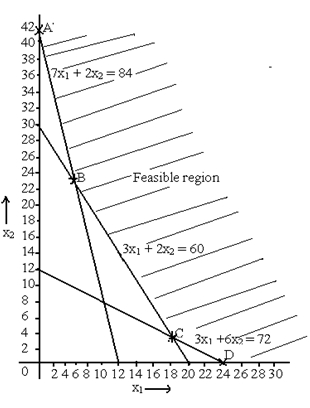Solved problems in Graphical Solution Procedure, sample assignments and homework
Questions: Minimize Z = 10x1 + 4x2
Subject to
3x1 + 2x2 ≥ 60
7x1 + 2x2 ≥ 84
3x1 +6x2 ≥ 72
x1 ≥ 0 , x2 ≥ 0
Answer
The first constraint 3x1 + 2x2 ≥ 60, can be written in form of equation
3x1 + 2x2 = 60
Place x1 =0, then x2 = 30
Place x2 =0, then x1 = 20
Then the coordinates are (0, 30) and (20, 0)
The second constraint 7x1 + 2x2 ≥ 84, can be written in form of equation
7x1 + 2x2 = 84
Place x1 =0, then x2 = 42
Place x2 =0, then x1 = 12
The coordinates then are (0, 42) and (12, 0)
The third constraint 3x1 +6x2 ≥ 72, can be written in form of equation
3x1 +6x2 = 72
Place x1 =0, then x2 = 12
Place x2 =0, then x1 = 24
Thus, coordinates are (0, 12) and (24, 0)
The graphical presentation is

The corner positions of feasible region are A, B, C and D. Thus the coordinates for the corner points are
A (0, 42)
B (6, 21) (Solve the two equations 7x1 + 2x2 = 84 and 3x1 + 2x2 = 60 to obtain the coordinates)
C (18, 3) Solve the two equations 3x1 +6x2 = 72 and 3x1 + 2x2 = 60 to obtain the coordinates)
D (24, 0)
We are given that Min Z = 10x1 + 4x2
At A (0, 42)
Z = 10(0) + 4(42) = 168
At B (6, 21)
Z = 10(6) + 4(21) = 144
At C (18, 3)
Z = 10(18) + 4(3) = 192
At D (24, 0)
Z = 10(24) + 4(0) = 240
The minimum value is calculated at the point B. Consequently Min Z = 144 and x1 = 6, x2 = 21